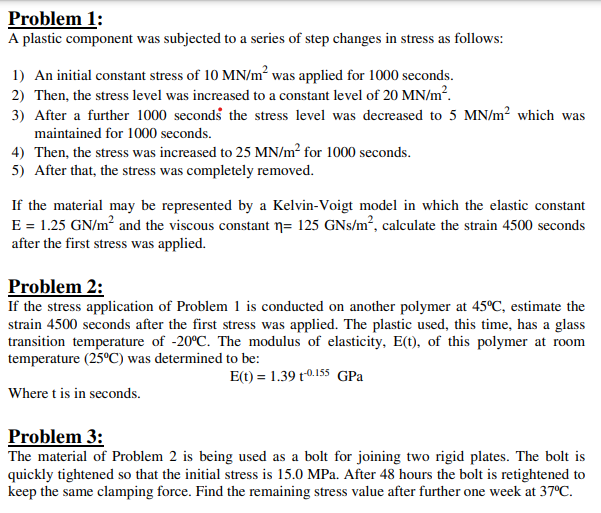Problem 1: A plastic component was subjected to a series of step changes in stress as follows: 1) An initial constant stress of 10 MN/m² was applied for 1000 seconds. 2) Then, the stress level was increased to a constant level of 20 MN/m². 3) After a further 1000 seconds the stress level was decreased to 5 MN/m² which was maintained for 1000 seconds. 4) Then, the stress was increased to 25 MN/m² for 1000 seconds. 5) After that, the stress was completely removed. If the material may be represented by a Kelvin-Voigt model in which the elastic constant E = 1.25 GN/m² and the viscous constant n= 125 GNs/m², calculate the strain 4500 seconds after the first stress was applied.
Problem 1: A plastic component was subjected to a series of step changes in stress as follows: 1) An initial constant stress of 10 MN/m² was applied for 1000 seconds. 2) Then, the stress level was increased to a constant level of 20 MN/m². 3) After a further 1000 seconds the stress level was decreased to 5 MN/m² which was maintained for 1000 seconds. 4) Then, the stress was increased to 25 MN/m² for 1000 seconds. 5) After that, the stress was completely removed. If the material may be represented by a Kelvin-Voigt model in which the elastic constant E = 1.25 GN/m² and the viscous constant n= 125 GNs/m², calculate the strain 4500 seconds after the first stress was applied.
Elements Of Electromagnetics
7th Edition
ISBN:9780190698614
Author:Sadiku, Matthew N. O.
Publisher:Sadiku, Matthew N. O.
ChapterMA: Math Assessment
Section: Chapter Questions
Problem 1.1MA
Related questions
Question
Please solve only problem 3.

Transcribed Image Text:Problem 1:
A plastic component was subjected to a series of step changes in stress as follows:
1) An initial constant stress of 10 MN/m² was applied for 1000 seconds.
2) Then, the stress level was increased to a constant level of 20 MN/m².
3) After a further 1000 seconds the stress level was decreased to 5 MN/m² which was
maintained for 1000 seconds.
4) Then, the stress was increased to 25 MN/m² for 1000 seconds.
5) After that, the stress was completely removed.
If the material may be represented by a Kelvin-Voigt model in which the elastic constant
E = 1.25 GN/m? and the viscous constant n= 125 GNs/m², calculate the strain 4500 seconds
after the first stress was applied.
Problem 2:
If the stress application of Problem 1 is conducted on another polymer at 45C, estimate the
strain 4500 seconds after the first stress was applied. The plastic used, this time, has a glass
transition temperature of -20°C. The modulus of elasticity, E(t), of this polymer at room
temperature (25°C) was determined to be:
E(t) = 1.39 t0.155 GPa
Where t is in seconds.
Problem 3:
The material of Problem 2 is being used as a bolt for joining two rigid plates. The bolt is
quickly tightened so that the initial stress is 15.0 MPa. After 48 hours the bolt is retightened to
keep the same clamping force. Find the remaining stress value after further one week at 37°C.
Expert Solution
This question has been solved!
Explore an expertly crafted, step-by-step solution for a thorough understanding of key concepts.
Step by step
Solved in 2 steps with 1 images

Knowledge Booster
Learn more about
Need a deep-dive on the concept behind this application? Look no further. Learn more about this topic, mechanical-engineering and related others by exploring similar questions and additional content below.Recommended textbooks for you

Elements Of Electromagnetics
Mechanical Engineering
ISBN:
9780190698614
Author:
Sadiku, Matthew N. O.
Publisher:
Oxford University Press

Mechanics of Materials (10th Edition)
Mechanical Engineering
ISBN:
9780134319650
Author:
Russell C. Hibbeler
Publisher:
PEARSON

Thermodynamics: An Engineering Approach
Mechanical Engineering
ISBN:
9781259822674
Author:
Yunus A. Cengel Dr., Michael A. Boles
Publisher:
McGraw-Hill Education

Elements Of Electromagnetics
Mechanical Engineering
ISBN:
9780190698614
Author:
Sadiku, Matthew N. O.
Publisher:
Oxford University Press

Mechanics of Materials (10th Edition)
Mechanical Engineering
ISBN:
9780134319650
Author:
Russell C. Hibbeler
Publisher:
PEARSON

Thermodynamics: An Engineering Approach
Mechanical Engineering
ISBN:
9781259822674
Author:
Yunus A. Cengel Dr., Michael A. Boles
Publisher:
McGraw-Hill Education

Control Systems Engineering
Mechanical Engineering
ISBN:
9781118170519
Author:
Norman S. Nise
Publisher:
WILEY

Mechanics of Materials (MindTap Course List)
Mechanical Engineering
ISBN:
9781337093347
Author:
Barry J. Goodno, James M. Gere
Publisher:
Cengage Learning

Engineering Mechanics: Statics
Mechanical Engineering
ISBN:
9781118807330
Author:
James L. Meriam, L. G. Kraige, J. N. Bolton
Publisher:
WILEY